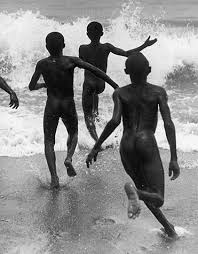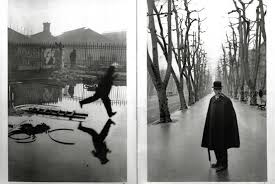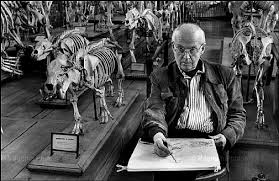 |
| Work by Eugene Atget |
He began photographing early in life, trying to emulate his French countryman Eugene Atget [
Link], whose equipment and technique dictated a view camera, tripod, lengthy exposures and posed subjects. Atget, whose imagery was used by the Surrealists, also connected in this way with Cartier-Bresson, who was distancing himself from the family business, turning to drawing and hanging around with artists.
 |
| Work by Martin Munkacsi |
He read Conrad's
Hearts of Darkness and went to Africa to hunt. While there, he was taking pictures with a Brownie he had been given. Eventually he tired of sport hunting, fell ill, eventually returning to France. He saw Munkacsi's dynamic and spontaneous 1929 picture titled "
Black Boys on the Shore of Lake Tangayika" and was inspired to take up photography. In 1932 he got his first Leica, a big step up from the Brownie he had been using.
His style emerged almost fully formed. Called by others a "...fusion of action, feeling and composition", this unity was derived from HCB's dedication to Buddhism. HCB was one of a handful of photographers from the era who practiced this belief [
Link], [
Link], HCB was influenced by Eugen Herrigel's then-popular book,
Zen in The Art of Archery, as in the quote below:
 |
| Works by Henri Cartier-Bresson |
"Bow, arrow, goal and ego melt into one another. As soon
as I take a bow and shoot, everything becomes so clear and
straightforward and ridiculously simple." --- HCB
“Fundamentally the marksman aimst at himself.”
Eugen Herrigel ~
Zen In The Art of Archery
HCB was a man of his time, a scion to a wealthy textile manufacturer, one who had fought during WWII against the Nazis and emerged first and foremost a
humanist, Buddhist and Communist. He believed in the power of collectivism, which few dare say (so as to not offend corporate donors) was the driving force behind
Magnum, the photographer's agency he helped found. Its mission was to take control of the photographs from media corporations (the interwebs of their day) and place it in the hands of emancipated creatives -- the photographers.
This battle would rage into the 50's, specifically with Joseph McCarthy and the attack and destruction of the
Photo-League, a debacle from which, it could be argued, photography did not recover for more than 3-to-5
decades. And
nothing like the Photo-League exists to this day.
Magnum divided the world into quadrants, and HCB drew the Far East. Before that he had already traveled to Africa, Mexico, the US and several other places.
Humanism and collectivism were broadly shared values among photographers at the time. HCB's humanism was not the drippy sentimentalism that characterized a lot of 1950's photography (as found in many photographs in Steichen's
Family of Man), but a deep, reverent vision of mankind.What made HCB's different was what he called
"the decisive moment". Think of it as the apex moment among many, like the big pearl in a necklace. The phrase was coined by one Cardinal Retz in the 17th century, who said: “There is nothing in this world that does not have a decisive moment.”
HCB thought of it as: "
To take
photographs means to recognize—simultaneously and within a fraction of a
second—both the fact itself and the rigorous organization of visually
perceived forms that give it meaning. It is putting one’s head, one’s
eye, and one’s heart on the same axis."
 |
| Work by Henri Cartier-Bresson |
HCB's photography of the Far East was the antidote to the
Orientalism of Fenton, Frith and many others. There was no hint of the earlier expression of assumed Western superiority. As one looks through the images made by HCB, one sees that he had earned their trust or blended in, and treated them with the same dignity as his own countrymen and friends.
 |
| Henri Cartier-Bresson drawing |
He considered himself a Surrealist, but he kept that close to his heart. At Magnum, what he did was considered Journalism, but he considered himself an observer of the human condition. In between all these travels, experiences and photographs, he was also involved in the cinema. Here is a list with brief descriptions [
Link]. He also never stopped drawing.
He married a Javanese dancer, whom he later divorced, then a well-known French photographer, Martine Franck, who did some great documentary type work and memorable portraits of her husband.
He often referred to composition as "geometry", a word that comes from the Indo-European for
"measure, see".
This exhibit at the Tampa Museum of Art is a
three-hundred and twenty print show, a retrospective that was done while HCB was alive and with his approval. It covers every aspect of his oeuvre, including his brilliant portraits.
 |
| Work by Henri Cartier-Bresson |
His work, philosophies and style inspired generations of street photographers and photojournalists for six decades to this day. More important, it influenced people like Robert Frank, Garry Winogrand, Diane Arbus, and too many others to list here to
build on what he achieved, and develop it not slavishly, but in their own ways.
I recommend this show without reservation, except to make sure you put enough money in the meter so you can give it enough time, and maybe take a break at the Sono cafe in between to think and talk with your companions about these excellent photographs, the times, mankind, philosophies and the man. We are very lucky to have this show here. See it at The Tampa Museum of Art, at 120 Gasparilla Plaza, adjacent to Curtis Hixon Park. The show runs through January 13th.
---
Luis














































